Apr 13, 2025
Apr 13, 2025

Atop the Chandragiri Hills in the town of Shravanabelagola, around 300 BC, Chandragupta Maurya renounced all worldly pleasures driven by Jain philosophy, and retired to this spot for peace and meditation. Driving down NH48 from Bengaluru, we arrive two hours later at the foot of the Vindhyagiri hills and join other tourists and devotees who flock to this place, climbing a steep ascent that is 470 feet high to get a glimpse of the 57 foot monolith of Gomateswara or Bahubali.
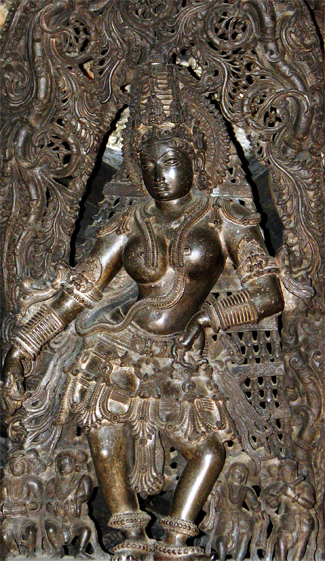 The monolith has withstood the ravages of time for over a thousand years and is a testament to the skill and talent of the artisans who carved this gigantic statue from a single granite rock. As you descend the steps you get a bird’s eye view of the scenic surroundings including a pond that is sandwiched between the two hills, also referred to as ‘Bela-kola’ or the white pond from which the name of the town is derived.
The monolith has withstood the ravages of time for over a thousand years and is a testament to the skill and talent of the artisans who carved this gigantic statue from a single granite rock. As you descend the steps you get a bird’s eye view of the scenic surroundings including a pond that is sandwiched between the two hills, also referred to as ‘Bela-kola’ or the white pond from which the name of the town is derived.
A short drive brings us to Belur, which was the historic capital of the Hoysala dynasty who ruled from the 10th through 14th centuries. The Hoysalas, much like the Chalukyas before them sparred with the Cholas and Pandyas down south and were patrons of art and architecture.
As you enter the Chennakesava temple in Belur, the immense courtyard reminds you of the Brihadeeswara temple in Tanjavur. The symmetrical design and grandeur of the entire temple as a whole is awe-inspiring. The guides here are multi-lingual and you soon learn about the beauty of soapstone which is the primary building block in this temple. Soapstone also known as steatite is a metamorphic rock which is soft and ideal for carving intricate structures that harden on exposure to the elements over time. The delicate features of the celestial dancers and their adornments highlight the precision of the artisans’ work and their creativity.
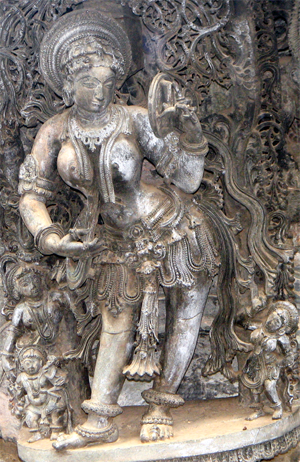 The outer walls are adorned with intricate carvings of mythological figures and animals including the lower frieze which is replete with hundreds of elephants. The vision of the Hoysalas coupled with the craftsmanship of their artisans a thousand years ago has resulted in such immense beauties for mere mortals to admire and appreciate.
The outer walls are adorned with intricate carvings of mythological figures and animals including the lower frieze which is replete with hundreds of elephants. The vision of the Hoysalas coupled with the craftsmanship of their artisans a thousand years ago has resulted in such immense beauties for mere mortals to admire and appreciate.
As the crow flies, another 16 km away is the twin city of Halebidu, the erstwhile capital of the Hoysalas prior to being sacked by the Delhi Sultanate, forcing them to retreat to Belur. The monument at Halebidu today is under the aegis of the Archaeological Survey of India. Equally impressive, the architecture once again speaks volumes about the skills of the artisans. The unique aspect in both places is that the figurines are projected as they would if they had been carved out of wood or metal. A pre-monsoon drizzle did not dampen our spirits as we took in the sights around us.
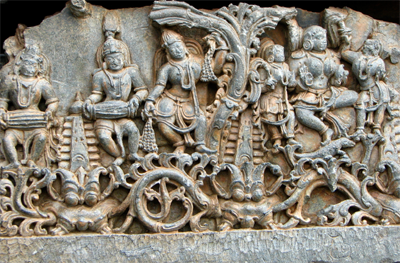 Both Belur and Halebidu are close to the city of Hassan where we spend the evening at the Hoysala Village Resort nestled amidst lush gardens and serene ambiance. You wake up in the morning to the music of birds, notably the Purple-rumped sunbird (male & female), Jungle Mynah, Red whiskered bulbul and Scaly-breasted Munia or spice finch that are abundant. From here we proceed to Mysore to visit the Royal Palace of the Wodeyars to get a glimpse into their lives many moons ago. The superb murals inside the palace come to life and tell a haunting story of the kings and queens and their opulent lifestyle as you are transported to an era long gone by.
Both Belur and Halebidu are close to the city of Hassan where we spend the evening at the Hoysala Village Resort nestled amidst lush gardens and serene ambiance. You wake up in the morning to the music of birds, notably the Purple-rumped sunbird (male & female), Jungle Mynah, Red whiskered bulbul and Scaly-breasted Munia or spice finch that are abundant. From here we proceed to Mysore to visit the Royal Palace of the Wodeyars to get a glimpse into their lives many moons ago. The superb murals inside the palace come to life and tell a haunting story of the kings and queens and their opulent lifestyle as you are transported to an era long gone by.
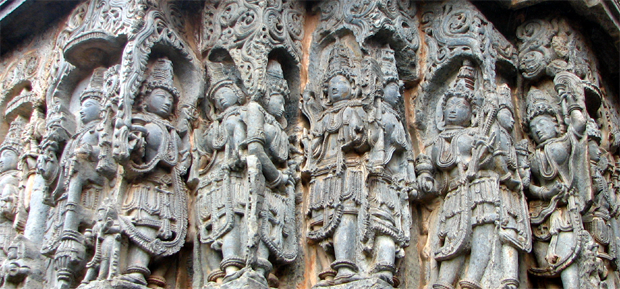
Leaving behind the city of palaces and urban commotion, we drive towards Nagarhole, into the wilderness. The drive is not bad except for the final stretch of 10 km that is covered with rain drenched potholes and perennial cattle that seem to have the right of way.
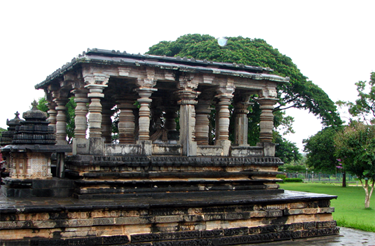 We arrive at the Jungle Lodge, formerly the hunting lodge of the Mysore Maharajah, located on the banks of the Kabini River. Surrounded by lush vegetation this place allows for true communion with nature. There is abundant birdlife here including Asian koel, Black- rumped flameback woodpecker and Oriental magpie robin.
We arrive at the Jungle Lodge, formerly the hunting lodge of the Mysore Maharajah, located on the banks of the Kabini River. Surrounded by lush vegetation this place allows for true communion with nature. There is abundant birdlife here including Asian koel, Black- rumped flameback woodpecker and Oriental magpie robin.
The highlight of our trip is a Jeep Safari into the Nagarhole National Park which is contiguous with the Bandipur, Wayanad and Mudumalai forests. A short drive over more potholes brings us eventually into the wild and we quickly spot a herd of Chital or spotted deer with the male proudly showing off its antlers.
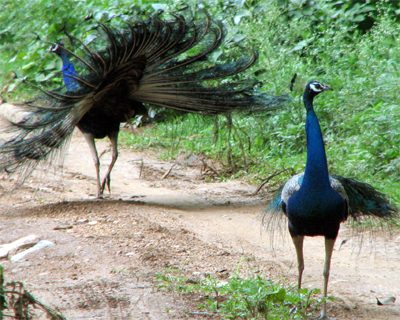 As we drive further, two peacocks strut in front of the vehicle and pose for us in a brilliant display of sensuous colors. Soon we hear the alarm call of a barking deer and our naturalist cautions us that there may be a predator lurking nearby. Immediately we hear rustling sounds in the canopy overhead which soon approaches a frenzied motion as the Langurs sway wildly from branch to branch having heeded the alarm call.
As we drive further, two peacocks strut in front of the vehicle and pose for us in a brilliant display of sensuous colors. Soon we hear the alarm call of a barking deer and our naturalist cautions us that there may be a predator lurking nearby. Immediately we hear rustling sounds in the canopy overhead which soon approaches a frenzied motion as the Langurs sway wildly from branch to branch having heeded the alarm call.
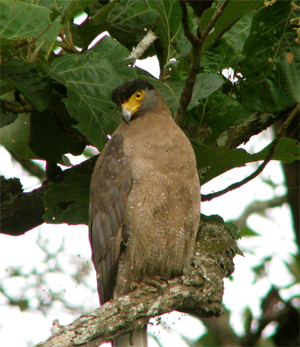 It is a terse but exciting moment as everyone sits quietly hoping to see a leopard or tiger. But as luck would have it nothing seems to cross our path although we learn later from another group that they happened to spot a leopard and its cub.
It is a terse but exciting moment as everyone sits quietly hoping to see a leopard or tiger. But as luck would have it nothing seems to cross our path although we learn later from another group that they happened to spot a leopard and its cub.
Heading towards the Kabini River we are treated to an awesome spectacle of over a hundred chital that are grazing peacefully. The only other odd creature is a wildboar that runs excitedly towards the water to take a quick sip while Egrets, cormorants and white-throated kingfishers dot the landscape.
Soon we spot a tusker and a herd of female elephants on the opposite bank which happens to be the Bandipur preserve.
As we head back we find ourselves within several feet of a huge tusker gracefully walking toward the river bank. It is an awesome sight no matter how many times you may have seen one of these creatures. Once he reaches the edge of the river he majestically turns and casts a glance at us and continues walking, while in the foreground several chital dash about in a playful mood. We end the day watching a wildlife documentary on wild-dogs and their family ties, shot in the nearby jungles and savor a hearty dinner at the Golghar in Jungle Lodge.
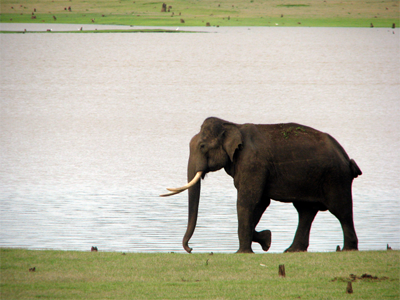 We wake up bright and early the next morning and after some deliberations about whether to take a boat ride or go back into the jungle, we opt for the latter just for the sheer thrill and excitement. Our naturalist is pleased with our option and he hopes we will spot a predator this morning. As soon as we enter the periphery of the forests, we spot an immense tusker, probably 50-55 years old a few yards directly in the line of our vehicle. As we wait and admire the beauty of this mammoth, he gracefully changes course and walks right into the woods. With the soft sunlight peering through the foliage, it is an awesome sight watching the tusker vanish gently into the woods. As we turn our heads to where the naturalist is pointing, we see a herd of several elephants anxiously waiting to cross the pathway. After a while we see a young male jump out of the woods and lead the way while a whole bunch of female elephants follow him. It is only after our naturalist points out that we are able to see a baby elephant tucked between several elephants that zealously guard it, the only giveaway being a tiny trunk that juts out between the beasts.
We wake up bright and early the next morning and after some deliberations about whether to take a boat ride or go back into the jungle, we opt for the latter just for the sheer thrill and excitement. Our naturalist is pleased with our option and he hopes we will spot a predator this morning. As soon as we enter the periphery of the forests, we spot an immense tusker, probably 50-55 years old a few yards directly in the line of our vehicle. As we wait and admire the beauty of this mammoth, he gracefully changes course and walks right into the woods. With the soft sunlight peering through the foliage, it is an awesome sight watching the tusker vanish gently into the woods. As we turn our heads to where the naturalist is pointing, we see a herd of several elephants anxiously waiting to cross the pathway. After a while we see a young male jump out of the woods and lead the way while a whole bunch of female elephants follow him. It is only after our naturalist points out that we are able to see a baby elephant tucked between several elephants that zealously guard it, the only giveaway being a tiny trunk that juts out between the beasts.
While we watch all this drama unfold in the wee hours of the morning, a lone Crested-serpent eagle sits perched above, most likely watching us. The sounds of birds fill the air, not to mention the haunting pitch of the brain fever bird. An Orange-headed thrush is sitting on a tree stump while a Red-wattled lapwing gently flies into a clearing and starts calling raucously.
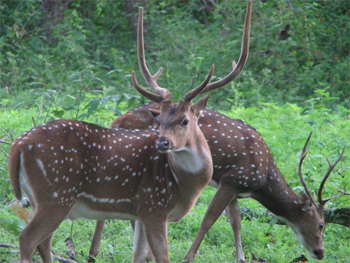 We amble forward and are stopped short in our tracks by the sight of an Indian Gaur or bison sitting majestically in the woods. When the drone of the engine stops, it turns its head so very slowly bringing into full focus its immense horns, that it sends a shudder down your spine and you are glad that it is resting. Perched on a teak trunk are two Blue Jay’s or Indian Roller’s while a pair of Rose-ringed parakeets swiftly flies in and out of the thick foliage. It is not easy to spot something readily unless there is a clearing and a huge Striped-necked mongoose makes it way through the bushes, momentarily stopping to stare back at us. We trudge back to the lodge, filled with memorable sightings of wildlife.
We amble forward and are stopped short in our tracks by the sight of an Indian Gaur or bison sitting majestically in the woods. When the drone of the engine stops, it turns its head so very slowly bringing into full focus its immense horns, that it sends a shudder down your spine and you are glad that it is resting. Perched on a teak trunk are two Blue Jay’s or Indian Roller’s while a pair of Rose-ringed parakeets swiftly flies in and out of the thick foliage. It is not easy to spot something readily unless there is a clearing and a huge Striped-necked mongoose makes it way through the bushes, momentarily stopping to stare back at us. We trudge back to the lodge, filled with memorable sightings of wildlife.
All images by the author.
07-Jun-2011
More by : Subra Narayan

|
thanks chuppa will visit this place sooner |

|
Wow! Thanks for taking us along on a great trip...it is mesmeric and tantalising enough for me to want to enjoy one such trip...the photographs too are lovely...wish you could have added more of birds... |